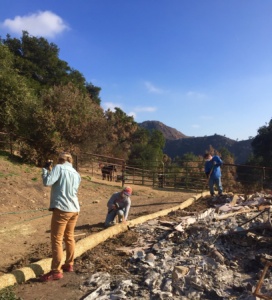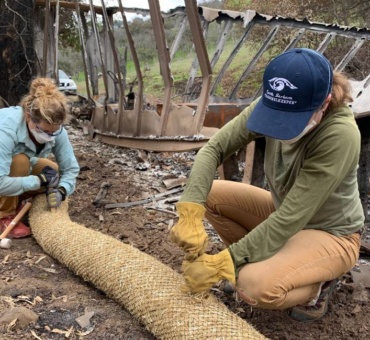In the months since the Alisal Fire burned nearly 17,000 acres on the Gaviota Coast, protecting the burn scar from erosion and local waterways from fire-related contaminants has become increasingly important—especially during the season of winter storms. Santa Barbara Channelkeeper and Heal the Ocean are working together as part of a larger community effort to minimize the impacts of rainstorms washing harmful contaminants to local creeks.

Thirteen structures were lost in the Alisal Fire, and many were located near Refugio Creek. Sediment, ash, and toxic materials, such as asbestos, heavy metals, and dioxin from burned sites can flow into local creeks, impairing water quality, damaging habitats, and increasing risk of pollutant exposure for wildlife. Installing temporary stormwater management measures to prevent pollutants from being carried to the creek, the local water supply, and the ocean has been critical.
In early November, local community groups recognized the need to assist property owners with cleanup of burned structures and initiated a series of meetings. The Alisal Fire Assistance Project, a collaborative community aid effort made up of five partner organizations and spearheaded by the Santa Barbara Bucket Brigade, was the result of these conversations. Partners worked to assess the burned sites for pollution risk and developed a plan to help mitigate contaminated stormwater runoff. Channelkeeper also received guidance from the Russian Riverkeeper, an organization which played a critical lead role in protecting Sonoma County watersheds following the Walbridge and Glass Fires in 2020.
In an early step in the project’s plan, Channelkeeper and Heal the Ocean leapt into action to protect areas in the Refugio Creek watershed from fire-related contaminants by installing stormwater control measures around burned structures before winter rains came. The Santa Barbara Bucket Brigade reached out to property owners to secure their approval and, over the course of three days, Channelkeeper’s six-person staff dug trenches and worked to install forty-five straw wattles, long tubes of compressed straw, at ten locations to contain fire-related pollutants.
“Working closely with other community groups to protect local creeks and assist affected property owners helped hasten the immediate response needed before the recent rainstorms,” explains Ted Morton, Channelkeeper’s Executive Director “Without the cooperation, we would not have been able to reach as many sites.”
“Channelkeeper had the person-power in place, but we needed to find a way to quickly pay for the materials and supplies,” said Channelkeeper’s Science and Policy Director, Ben Pitterle. “That’s when Hillary Hauser from Heal the Ocean stepped in and offered to provide all of the materials that we needed to do this work.”
”Heal the Ocean raises funds for issues exactly like this,” said Hillary Hauser, Executive Director of Heal the Ocean. “To keep these pollutants from getting into the watershed – and ocean – is crucial, and there is not a question about helping. We’re grateful for Channelkeeper doing all the heavy lifting.”
Additional partners collaborating on the Alisal Fire Assistance Project include the Santa Barbara Bucket Brigade, Santa Barbara County Fire Safe Council, and the Community Environmental Council. By sharing expertise, resources, and project responsibilities, the five organizations hope to provide aid and address post-fire recovery effectively, and quickly.
Santa Barbara Channelkeeper and Heal the Ocean are pleased to join other local organizations to support neighbors and protect local waterways through this meaningful partnership. We are stronger together.
For information on how to support the Alisal Fire Assistance Project visit: http://sbbucketbrigade.org/afap/
